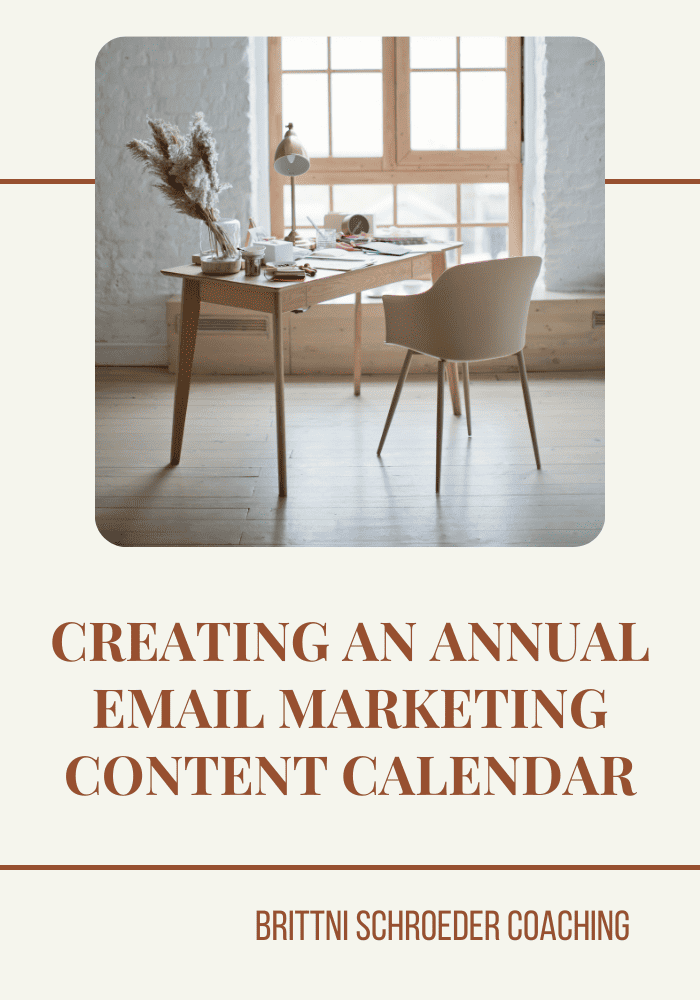
brittni schroeder
BLOG
Brittni Schroeder Coaching
Creating An Annual Email
Marketing Content Calendar

Email marketing remains one of the most effective and personal ways to engage with your audience. However, successful email marketing requires careful planning and consistent effort. This is where an annual email marketing content calendar comes into play. In this blog, we’ll explore the importance of creating an annual email marketing content calendar for your email marketing campaigns and provide a step-by-step guide on how to create one that sets you up for success throughout the year.
Why You Need an Email Marketing Content Calendar
Before diving into the process of creating an annual email marketing content calendar, let’s understand why it’s crucial for your business.
Consistency is Key
Consistency is a fundamental aspect of email marketing success. Your subscribers expect to hear from you regularly, and a content calendar helps ensure that you send emails consistently. This, in turn, keeps your audience engaged and informed about your products, services, or updates — and it also builds the know, like, and trust factor.
Strategic Planning
A content calendar allows you to plan your email marketing campaigns strategically. You can align your emails with specific marketing goals, product launches, or seasonal promotions. This strategic approach helps you make the most of your email marketing efforts. When you’re strategic with your content, it allows you to align your content with your current offers.
Successful Collaborations
If you use collaborations to scale your business, having a content calendar helps organize and streamline collaboration. You can see what’s in the pipeline, plan tasks accordingly, and schedule collaborations with plenty of time.
Data-Driven Optimization
With a content calendar, you can analyze the performance of your email campaigns more effectively. By tracking open rates, click-through rates, and conversions for each email, you can tweak and improve your strategy over time, ensuring that your emails become increasingly effective.
Now that you understand the importance of an email marketing content calendar, let’s walk through the steps to create one.
Step 1: Define Your Goals and Objectives
Start by outlining your email marketing goals and objectives for the year. What do you want to achieve with your email campaigns? Common objectives include increasing sales, growing your subscriber list, enhancing brand awareness, and nurturing customer relationships. Clear goals will guide your content creation and help you measure success.
Step 2: Identify Key Dates and Events
Next, identify the key dates and events that will influence your email marketing throughout the year. These can include holidays, your birthday, product launches, industry events, and other significant milestones. Make a list of these dates in your calendar.
Step 3: Market Research
Perform regular market research by sending out questionnaires 2-3 times a year that ask your list to help you out and give you feedback on what they would like to see.
Step 4: Segment Your Audience
Understanding your audience is crucial for crafting effective email campaigns. Segment your email list based on factors like demographics, purchase history, and engagement level. This segmentation will enable you to tailor your content to specific audience segments and increase relevance.
Step 5: Plan Your Email Content
Now it’s time to plan the actual email content for each campaign. Consider the following when crafting your email content:
- Content Categories. Determine the types of emails you’ll send. These may include promotional emails, newsletters, educational content, customer testimonials, and more.
- Message and Value Proposition. What message do you want to convey in each email? What value are you providing to your subscribers? Your content should align with your goals and resonate with your audience.
- Visuals and Design. Plan the visuals and design elements for your emails. Consistency in branding, imagery, and layout will help strengthen your brand identity.
- Call to Action (CTA). Every email should have a clear and compelling CTA that guides the reader on what to do next, whether it’s making a purchase, signing up for a webinar, or downloading an e-book.
Step 6: Create Email Templates
Now that you have a clear plan for your email content, it’s time to create email templates. Consider the different emails that you send (podcast, blog, recipes, tutorials, etc.). Create templates that are relevant to those categories.
Step 7: Populate Your Calendar
Start populating your content calendar by filling in the details for each email campaign. Begin with the most critical campaigns, such as holiday promotions or product launches. Ensure that your emails are spaced out evenly to maintain consistency in your communication..
Step 8: Review and Adjust
Regularly review your email marketing content calendar to ensure that it aligns with your goals and objectives. Be prepared to adjust your schedule if unexpected opportunities or challenges arise throughout the year.
Step 9: Automate and Schedule
To streamline your email marketing efforts, consider using an email marketing platform that allows you to automate and schedule your campaigns. This will help ensure that your emails are sent at the right time, even when you’re not actively managing them.
Your email marketing content calendar should not be static. As you learn more about your audience and the effectiveness of your campaigns, be willing to adapt and evolve your strategy. Experiment with different content types, subject lines, and messaging to continuously improve your results.
Creating an annual email marketing content calendar is a critical step in achieving email marketing success. It helps you maintain consistency, plan strategically, allocate resources efficiently, and optimize your campaigns over time. By following the steps outlined in this guide and remaining flexible in your approach, you’ll be well-prepared to engage and nurture your audience throughout the year. Remember that email marketing is not just about sending messages; rather, it’s about building lasting relationships with your subscribers.






